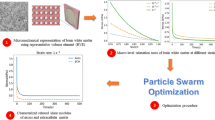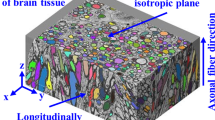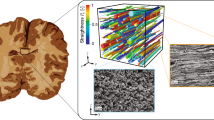Abstract
Brain’s micro-structure plays a critical role in its macro-structure material properties. Since the structural anisotropy in the brain white matter has been introduced due to axonal fibers, considering the direction of axons in the continuum models has been mediated to improve the results of computational simulations. The aim of the current study was to investigate the role of fiber direction in the material properties of brain white matter and compare the mechanical behavior of the anisotropic white matter and the isotropic gray matter. Diffusion tensor imaging (DTI) was employed to detect the direction of axons in white matter samples, and tensile stress-relaxation loads up to 20% strains were applied on bovine gray and white matter samples. In order to calculate the nonlinear and time-dependent properties of white matter and gray matter, a visco-hyperelastic model was used. The results indicated that the mechanical behavior of white matter in two orthogonal directions, parallel and perpendicular to axonal fibers, are significantly different. This difference indicates that brain white matter could be assumed as an anisotropic material and axons have contribution in the mechanical properties. Also, up to 15% strain, white matter samples with axons parallel to the force direction are significantly stiffer than both the gray matter samples and white matter samples with axons perpendicular to the force direction. Moreover, the elastic moduli of white matter samples with axons both parallel and perpendicular to the loading direction and gray matter samples at 15–20% strain are not significantly different. According to these observations, it is suggested that axons have negligible roles in the material properties of white matter when it is loaded in the direction perpendicular to the axon direction. Finally, this observation showed that the anisotropy of brain tissue not only has effects on the elastic behavior, but also has effects on the viscoelastic behavior.






Similar content being viewed by others
References
Alfasi, A. M., A. V. Shulyakov, and M. R. Del Bigio. Intracranial biomechanics following cortical contusion in live rats. J. Neurosurg. 119:1255–1262, 2013.
Arbogast, K. B., and S. S. Margulies. Material characterization of the brainstem from oscillatory shear tests. J. Biomech. 31:801–807, 1998.
Atay, S. M., C. D. Kroenke, A. Sabet, and P. V. Bayly. Measurement of the dynamic shear modulus of mouse brain tissue in vivo by magnetic resonance elastography. J. Biomech. Eng. 130:021013, 2008.
Auhustinack, J. Direct visualization of the perforant pathway in the human brain with ex vivo diffusion tensor imaging. Front. Hum. Neurosci. 4:1–13, 2010.
Bain, A. C., and D. F. Meaney. Tissue-level thresholds for axonal damage in an experimental model of central nervous system white matter injury. J. Biomech. Eng. 122:615–622, 2000.
Basser, P. J., J. Mattiello, and D. LeBihan. MR diffusion tensor spectroscopy and imaging. Biophys. J. 66:259–267, 1994.
Bayly, P. V., E. E. Black, R. C. Pedersen, E. P. Leister, and G. M. Genin. In vivo imaging of rapid deformation and strain in an animal model of traumatic brain injury. J. Biomech. 39:1086–1095, 2006.
Berns, G. S., P. F. Cook, S. Foxley, S. Jbabdi, K. L. Miller, and L. Marino. Diffusion tensor imaging of dolphin brains reveals direct auditory pathway to temporal lobe. Proc. R. Soc. B Biol. Sci. 282:20151203, 2015.
Budday, S., R. Nay, R. de Rooij, P. Steinmann, T. Wyrobek, T. C. Ovaert, and E. Kuhl. Mechanical properties of gray and white matter brain tissue by indentation. J. Mech. Behav. Biomed. Mater. 46:318–330, 2015.
Budday, S., T. C. Ovaert, G. A. Holzapfel, P. Steinmann, and E. Kuhl. Fifty shades of brain: a review on the mechanical testing and modeling of brain tissue. Arch. Comput. Methods Eng. 2019. https://doi.org/10.1007/s11831-019-09352-w.
Budday, S., M. Sarem, L. Starck, G. Sommer, J. Pfefferle, N. Phunchago, E. Kuhl, F. Paulsen, P. Steinmann, V. P. Shastri, and G. A. Holzapfel. Towards microstructure-informed material models for human brain tissue. Acta Biomater. 104:53–65, 2020.
Budday, S., G. Sommer, C. Birkl, C. Langkammer, J. Haybaeck, J. Kohnert, M. Bauer, F. Paulsen, P. Steinmann, E. Kuhl, and G. A. Holzapfel. Mechanical characterization of human brain tissue. Acta Biomater. 48:319–340, 2017.
Carlsen, R. W., and N. P. Daphalapurkar. The importance of structural anisotropy in computational models of traumatic brain injury. Front. Neurol. 6:1–6, 2015.
Chatelin, S., J. Vappou, S. Roth, J. S. Raul, and R. Willinger. Towards child versus adult brain mechanical properties. J. Mech. Behav. Biomed. Mater. 6:166–173, 2012.
Christ, A. F., K. Franze, H. Gautier, P. Moshayedi, J. Fawcett, R. J. M. Franklin, R. T. Karadottir, and J. Guck. Mechanical difference between white and gray matter in the rat cerebellum measured by scanning force microscopy. J. Biomech. 43:2986–2992, 2010.
Dennerll, T. J., P. Lamoureux, R. E. Buxbaum, and S. R. Heidemann. The cytomechanics of axonal elongation and retraction. J. Cell Biol. 109:3073–3083, 1989.
Elkin, B. S., L. F. Gabler, M. B. Panzer, and G. P. Siegmund. Brain tissue strains vary with head impact location: a possible explanation for increased concussion risk in struck versus striking football players. Clin. Biomech. 64:49–57, 2019.
Eskandari, F., M. Shafieian, M. M. Aghdam, and K. Laksari. A knowledge map analysis of brain biomechanics: current evidence and future directions. Clin. Biomech. 75:105000, 2020.
Eskandari, F., M. Shafieian, M. M. Aghdam, and K. Laksari. Tension strain-softening and compression strain-stiffening behavior of brain white matter. Ann. Biomed. Eng. 2020. https://doi.org/10.1007/s10439-020-02541-w.
Feng, Y., E. H. Clayton, Y. Chang, R. J. Okamoto, and P. V. Bayly. Viscoelastic properties of the ferret brain measured in vivo at multiple frequencies by magnetic resonance elastography. J. Biomech. 46:863–870, 2013.
Feng, Y., Y. Gao, T. Wang, L. Tao, S. Qiu, and X. Zhao. A longitudinal study of the mechanical properties of injured brain tissue in a mouse model. J. Mech. Behav. Biomed. Mater. 71:407–415, 2017.
Feng, Y., C. H. Lee, L. Sun, S. Ji, and X. Zhao. Characterizing white matter tissue in large strain via asymmetric indentation and inverse finite element modeling. J. Mech. Behav. Biomed. Mater. 65:490–501, 2017.
Feng, Y., R. J. Okamoto, R. Namani, G. M. Genin, and P. V. Bayly. Measurements of mechanical anisotropy in brain tissue and implications for transversely isotropic material models of white matter. J. Mech. Behav. Biomed. Mater. 23:117–132, 2013.
Finan, J. D., S. N. Sundaresh, B. S. Elkin, G. M. McKhann, and B. Morrison. Regional mechanical properties of human brain tissue for computational models of traumatic brain injury. Acta Biomater. 55:333–339, 2017.
Fung, Y.-C. Biomechanics: Mechanical Properties of Living Tissues. New York: Springer, 1993. https://doi.org/10.1007/978-1-4757-2257-4.
Garimella, H. T., and R. H. Kraft. Modeling the mechanics of axonal fiber tracts using the embedded finite element method. Int. J. Numer. Methods Biomed. Eng. 33:e2823, 2017.
Gefen, A., and S. S. Margulies. Are in vivo and in situ brain tissues mechanically similar? J. Biomech. 37:1339–1352, 2004.
Giordano, C., and S. Kleiven. Connecting fractional anisotropy from medical images with mechanical anisotropy of a hyperviscoelastic fibre-reinforced constitutive model for brain tissue. J. R. Soc. Interfaces 11:20130914, 2014.
Giordano, C., S. Zappalà, and S. Kleiven. Anisotropic finite element models for brain injury prediction: the sensitivity of axonal strain to white matter tract inter-subject variability. Biomech. Model. Mechanobiol. 16:1269–1293, 2017.
Green, M. A., L. E. Bilston, and R. Sinkus. In vivo brain viscoelastic properties measured by magnetic resonance elastography. NMR Biomed. 21:755–764, 2008.
Guilfoyle, D. N., J. A. Helpern, and K. O. Lim. Diffusion tensor imaging in fixed brain tissue at 7.0 T. NMR Biomed. 16:77–78164, 2003.
Holzapfel, G. A. Nonlinear Solid Mechanics II. New York: Wiley, 2000.
Ji, S., W. Zhao, Z. Li, and T. W. McAllister. Head impact accelerations for brain strain-related responses in contact sports: a model-based investigation. Biomech. Model. Mechanobiol. 13:1121–1136, 2014.
Laksari, K., S. Assari, B. Seibold, K. Sadeghipour, and K. Darvish. Computational simulation of the mechanical response of brain tissue under blast loading. Biomech. Model. Mechanobiol. 14:459–472, 2015.
Laksari, K., M. Shafieian, and K. Darvish. Constitutive model for brain tissue under finite compression. J. Biomech. 45:642–646, 2012.
Leemans, A., B. Jeurissen, J. Sijbers, and D. K. Jones. ExploreDTI: a graphical toolbox for processing, analyzing, and visualizing diffusion MR data. Proc. Int. Soc. Magn. Reson. Med. 17:3537, 2009.
Meaney, D. F. Relationship between structural modeling and hyperelastic material behavior: application to CNS white matter. Biomech. Model. Mechanobiol. 1:279–293, 2003.
Meaney, D. F., B. Morrison, and C. Dale BassDale Bass. The mechanics of traumatic brain injury: a review of what we know and what we need to know for reducing its societal burden. J. Biomech. Eng. 2014. https://doi.org/10.1115/1.4026364.
Miller, K., K. Chinzei, G. Orssengo, and P. Bednarz. Mechanical properties of brain tissue in-vivo: experiment and computer simulation. J. Biomech. 33:1369–1376, 2000.
Mori, S., and J. Zhang. Principles of diffusion tensor imaging and its applications to basic neuroscience research. Neuron 51:527–539, 2006.
Murphy, J. G. Evolution of anisotropy in soft tissue. Proc. R. Soc. A Math. Phys. Eng. Sci. 2014. https://doi.org/10.1098/rspa.2013.0548.
Perepelyuk, M., L. Chin, X. Cao, A. van Oosten, V. B. Shenoy, P. A. Janmey, and R. G. Wells. Normal and fibrotic rat livers demonstrate shear strain softening and compression stiffening: a model for soft tissue mechanics. PLoS ONE 11:e0146588, 2016.
Prange, M. T., and S. S. Margulies. Regional, directional, and age-dependent properties of the brain undergoing large deformation. J. Biomech. Eng. 124:244–252, 2002.
Prevost, T. P., G. Jin, M. A. de Moya, H. B. Alam, S. Suresh, and S. Socrate. Dynamic mechanical response of brain tissue in indentation in vivo, in situ and in vitro. Acta Biomater. 7:4090–4101, 2011.
Qiu, S., W. Jiang, M. S. Alam, S. Chen, C. Lai, T. Wang, X. Li, J. Liu, M. Gao, Y. Tang, X. Li, J. Zeng, and Y. Feng. Viscoelastic characterization of injured brain tissue after controlled cortical impact (CCI) using a mouse model. J. Neurosci. Methods 330:108463, 2020.
Sahoo, D., C. Deck, and R. Willinger. Brain injury tolerance limit based on computation of axonal strain. Accid. Anal. Prev. 92:53–70, 2016.
Samadi-Dooki, A., G. Z. Voyiadjis, and R. W. Stout. An indirect indentation method for evaluating the linear viscoelastic properties of the brain tissue. J. Biomech. Eng. 139:061007, 2017.
Sarvghad-Moghaddam, H., A. Rezaei, M. Ziejewski, and G. Karami. Correlative analysis of head kinematics and brain’s tissue response: a computational approach toward understanding the mechanisms of blast TBI. Shock Waves 27:919–927, 2017.
Schmierer, K., C. A. M. Wheeler-Kingshott, P. A. Boulby, F. Scaravilli, D. R. Altmann, G. J. Barker, P. S. Tofts, and D. H. Miller. Diffusion tensor imaging of post mortem multiple sclerosis brain. Neuroimage 35:467–477, 2007.
Shafieian, M., K. K. Darvish, and J. R. Stone. Changes to the viscoelastic properties of brain tissue after traumatic axonal injury. J. Biomech. 42:2136–2142, 2009.
Shi, L., Y. Han, H. Huang, J. Davidsson, and R. Thomson. Evaluation of injury thresholds for predicting severe head injuries in vulnerable road users resulting from ground impact via detailed accident reconstructions. Biomech. Model. Mechanobiol. 2020. https://doi.org/10.1007/s10237-020-01312-9.
Shuck, L. Z., and S. H. Advani. Rheological response of human brain tissue in shear. J. Basic Eng. 94:905–911, 1972.
van Oosten, A. S. G., X. Chen, L. Chin, K. Cruz, A. E. Patteson, K. Pogoda, V. B. Shenoy, and P. A. Janmey. Emergence of tissue-like mechanics from fibrous networks confined by close-packed cells. Nature 573:96–101, 2019.
Velardi, F., F. Fraternali, and M. Angelillo. Anisotropic constitutive equations and experimental tensile behavior of brain tissue. Biomech. Model. Mechanobiol. 5:53–61, 2006.
Weickenmeier, J., R. de Rooij, S. Budday, P. Steinmann, T. C. Ovaert, and E. Kuhl. Brain stiffness increases with myelin content. Acta Biomater. 42:265–272, 2016.
Wright, R. M., and K. T. Ramesh. An axonal strain injury criterion for traumatic brain injury. Biomech. Model. Mechanobiol. 11:245–260, 2012.
Wu, T., A. Alshareef, J. S. Giudice, and M. B. Panzer. Explicit modeling of white matter axonal fiber tracts in a finite element brain model. Ann. Biomed. Eng. 47:1908–1922, 2019.
Yousefsani, S. A., A. Shamloo, and F. Farahmand. Nonlinear mechanics of soft composites: hyperelastic characterization of white matter tissue components. Biomech. Model. Mechanobiol. 19:1143–1153, 2020.
Zhang, W., L. Liu, Y. Xiong, Y. Liu, S. Yu, C. Wu, and W. Guo. Effect of in vitro storage duration on measured mechanical properties of brain tissue. Sci. Rep. 8:1247, 2018.
Zhao, W., and S. Ji. White Matter Anisotropy for Impact Simulation and Response Sampling in Traumatic Brain Injury. J. Neurotrauma 36:250–263, 2019.
Zhu, Z., C. Jiang, and H. Jiang. A visco-hyperelastic model of brain tissue incorporating both tension/compression asymmetry and volume compressibility. Acta Mech. 230:2125–2135, 2019.
Zlomuzica, A., S. Binder, and E. Dere. Gap Junctions in the Brain. New York: Elsevier, 2013. https://doi.org/10.1016/b978-0-12-415901-3.00001-3.
Acknowledgments
The authors wish to acknowledge the National Brain Mapping Lab (NBML), Tehran, Iran, for providing services for DTI acquisition and thank Fargol R. Araghi and Farzaneh Eskandari for assistance in mechanical testing.
Funding
Authors have not received any funding for this research.
Conflict of interest
The authors declare that they have no conflict of interest.
Author information
Authors and Affiliations
Corresponding author
Additional information
Associate Editor Joel Stitzel oversaw the review of this article.
Publisher's Note
Springer Nature remains neutral with regard to jurisdictional claims in published maps and institutional affiliations.
Rights and permissions
About this article
Cite this article
Eskandari, F., Shafieian, M., Aghdam, M.M. et al. Structural Anisotropy vs. Mechanical Anisotropy: The Contribution of Axonal Fibers to the Material Properties of Brain White Matter. Ann Biomed Eng 49, 991–999 (2021). https://doi.org/10.1007/s10439-020-02643-5
Received:
Accepted:
Published:
Issue Date:
DOI: https://doi.org/10.1007/s10439-020-02643-5




